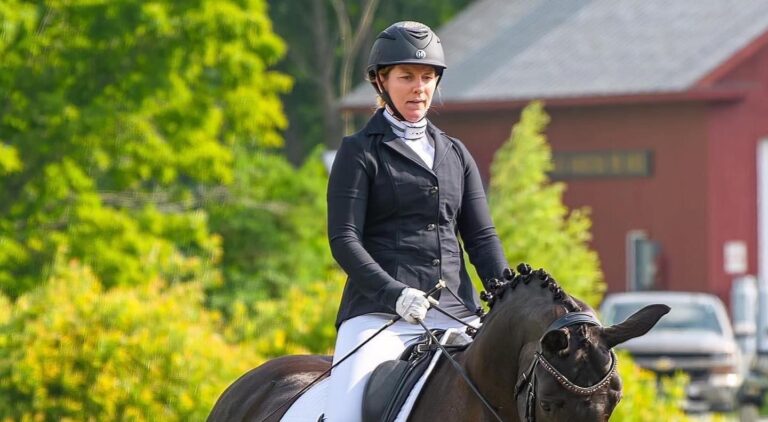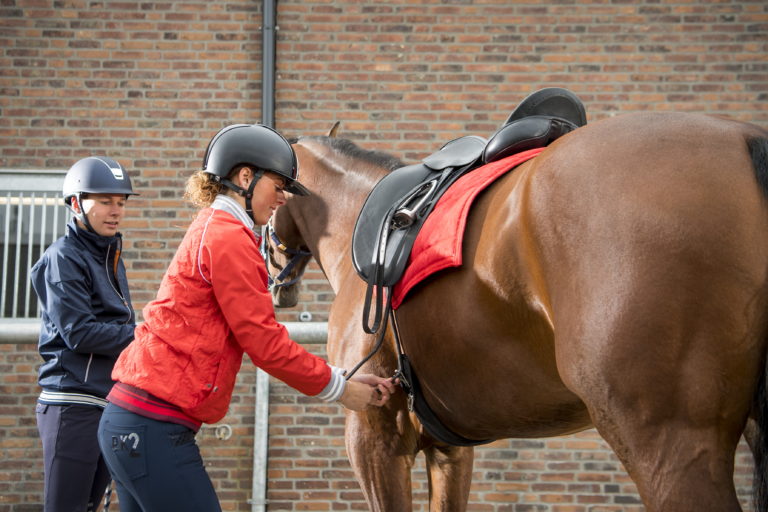
The shoulder-in is the first lateral movement involving collection that you encounter as you move up the dressage levels. Introduced at Second Level, it is one of the most important movements for you and your horse to master.
First, it allows you to move the horse’s shoulders. This is necessary for more advanced collection that requires, among other abilities, the mobility and elevation of the shoulders.
It also allows the rider to displace the shoulders without the horse thinking that he must move in the direction the shoulders are pointed. Moving the shoulders to the inside is also necessary for the horse to bend correctly.
But there are lots of things that can go wrong with shoulder-in. Let’s look at a few of these problems and some possible solutions:
1 Problem: My horse has too much angle.
This is a control and line-of-travel issue. The horse is working hard to avoid collection by changing the angle. Think of riding your outside hand to the corner of the arena with your inside leg. I find it helpful to look where I am going rather than looking over the horse’s ears. If you are doing shoulder-in on the centerline, then ride your outside hand to C. Often, you can help the horse understand that the inside leg and outside rein control the angle by only doing a few steps of shoulder-in, straightening a few strides, and then repeating the shoulder-in.
2 Problem: My horse has too much bend in his neck.

As a rider, you need to pay more attention to the relationship between your upper body and the horse’s shoulders, neck, and head. I have a visual I use called “the gunslinger”: imagine you are on Main Street ready to draw your guns in a gunfight with your shoulders square and facing your opponent. It’s the same when you are riding a straight line: your horse’s shoulders, neck, and ears line up with yours. If you were to draw your guns on a straight line, you should be able to shoot exactly over each of your horse’s ears.
In shoulder-in, the rider must turn her shoulders and the horse’s shoulders, neck, and ears toward the opposite corner of the arena. Here the gunslinger analogy remains true. You should have a direct line from your shoulder, elbow, and hand to the horse’s shoulder and ear on each side. If you have too much neck bend, the horse’s outside ear will be in the middle of your chest, not in front of your outside shoulder and hand. You either have too much inside rein or are allowing too much neck bend with the outside rein.
3 Problem: My horse tilts his head.
This imperfection is due to a lack of suppleness in the horse’s poll. The poll is usually the last piece that becomes supple in a horse. This being said, it is impossible to supple the poll with the neck up in the beginning. Work on poll-suppling exercises during the warm-up phase of your training session. Sometimes head tilting can be addressed by simply changing the flexion for a few strides and then returning to the correct position.
4 Problem: My horse’s haunches fall out.
Again, this is a line-of-travel issue and an “escape” for the horse. It can usually be solved with a reminder from the outside leg in the preparation for the movement. I also find it helpful to do a little head-to-wall leg-yielding on one long side and then a shoulder-in on the next long side. You may need to have a bit less displacement of the shoulders for a while until the horse becomes more supple and obedient to the exercise.
5 Problem: My horse falls to his outside shoulder.

This can happen when the horse resists taking the weight on his inside hind leg and uses the outside shoulder to maintain balance, instead. Check this first: Do you have too much neck bend? This will usually result in the balance going to the outside shoulder.
The best exercise I know for correcting this issue is to change from shoulder-in to haunches-out (renvers) for a few strides. When you return to the shoulder-in, you should have the correct balance.
6 Problem: My horse loses cadence and regularity.
This is a simple issue of lack of lateral suppleness. When the judge sees a loss of regularity (purity of gait) in a lateral movement, it does not influence the gait score, but does influence the submission score. You will need to go back and work on bending exercises such as circles, serpentines, and figure eights before adding bending with collection to your training plan.
7 Problem: My horse loses impulsion.
This is normal. Most green or young horses need to slow down a bit to learn something new. Try to go forward first out of the corner and then do a few strides of shoulder-in, straighten, and go forward again. Using a bit of a more-forward working or collected trot will help the horse “think” forward first.
8 Problem: My horse’s haunches fall in off the track.
This horse is really sneaky. He allows you to begin the movement in a good way, happily bringing his forehand off the track. However, he then “cheats” simply by moving his hindquarters slightly in, and is soon just going straight down the second track.
Be sure your outside leg is not sending the wrong message. If this is not the issue, then you need to work again to emphasize the inside leg to the outside rein. Go back to the leg-yield with some bending into the shoulder-in. I am not big on pushing the haunches back onto the track when this mistake occurs. I believe the horse should always be straightened by placing the shoulders in front of the hind legs. So when this problem crops up, you can just bring the shoulders more to the inside until you have a three-track movement. You might end up on the centerline but you will have made your point!

This excerpt from Dressage for the Not-So-Perfect Horse by Janet Foy with Nancy J. Jones is reprinted with permission from Trafalgar Square Books (www.HorseandRiderBooks.com).











